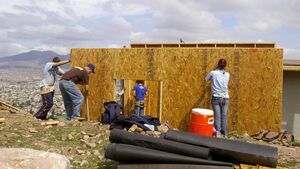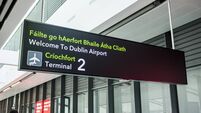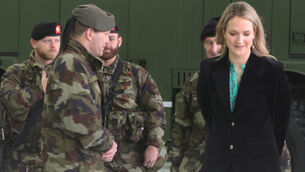Herald Opinion: Missionaries on a mission to serve humanity

Irish missionaries are far from relics. They are the great unseen, carrying out work that rarely makes headlines until tragedy strikes. Pic; iStock
Missionaries. I’ll admit, I thought they were a thing of the past. In my mind they were priests and nuns in far-flung places, spreading the faith, doing “mission work” in what we used to call the Third World.
As a child, “the missions” were part of the air we breathed. People from Loughglynn went abroad to serve, and the convent behind the village was a central focus of the Franciscan Missionaries of Mary. Before my time, nuns were trained there; in my time, it was a place where sisters retired after a lifetime overseas. We’d hear stories about places like Ceylon, China, Nigeria, the Philippines - countries that seemed impossibly far away. Sometimes a missionary priest would serve as chaplain in the convent, and his Sunday homily might include tales from a mission station in Nigeria, Kenya or a remote island in the Pacific.
Missionary life felt close enough to touch, even if I didn’t fully understand it. Then, at the dawn of the new millennium, the convent closed. An era ended, leaving behind an empty building - still standing, but only as a quiet reminder of a once-lively calling.
For years afterwards, missionaries barely crossed my mind. As a student of history, I knew of Gall, Killian, and Columbanus - wandering monks who carried their faith across Europe - but they belonged to another age, romanticised and almost mythical. And then I heard about Gena Heraty.
Gena is a Mayo woman who has spent 32 years as a lay missionary in Haiti, running the Sainte-Hélène orphanage in Kenscoff, caring for some of the country’s most vulnerable children. Her story pulled me into a very different understanding of what missionaries are, and what they do.
Hers is a life shaped by a country scarred by political instability. In the 1970s and ’80s, Haiti endured the dictatorship of Jean-Claude “Baby Doc” Duvalier, who inherited power at just 19 from his father, François “Papa Doc.” Those years were marked by deep corruption, brutal repression through the feared Tonton Macoute, and the siphoning of public funds. When Duvalier fled into exile in 1986, he left behind a country stripped of resources and trust. The wounds never healed.
In the decades since, Haiti has endured natural disasters, gang violence, and chronic political turmoil. Earthquakes have levelled neighbourhoods. Hurricanes have destroyed crops and homes. Today, heavily armed gangs control much of the capital, and aid workers operate in one of the most dangerous environments in the world.
Last week, Gena was kidnapped along with seven colleagues from the orphanage. It was not her first brush with danger. In 2010, she survived the earthquake that killed a co-worker. In another incident, armed men stormed the orphanage, assaulted her, threatened to kill her, and murdered a staff member.
And yet, she stayed.
What I didn’t fully appreciate until recently is that missionary work today often goes far beyond preaching or conversion. In many cases, it involves education, healthcare, development work, and advocacy for social justice—helping communities to build capacity and respond to challenges in ways that respect their culture and dignity. They are not just religious envoys; they are people committed to service and solidarity.
They are the same kinds of people who work in our schools, hospitals, and care homes here in Ireland—except they go to the poorest places, to people who have nothing, and try to help them build a future.
I remember, many years ago, being deeply moved by news reports from Romania after the collapse of CeauÈescu’s dictatorship in the early 1990s. I remember Romania’s Communist dictator being executed around Christmas in 1989.
Then came images of abandoned children in orphanages, malnourished, neglected, lying in cots all day, which shook many of us. I even considered volunteering there, but to my regret, I never followed through. I have since met two people who saw those same reports and did go, spending time caring for those children. That is what separates good intentions from action.
And crises like these are not unique to the past. Today, the nightly news from Gaza brings the same sense of urgency and despair. We hear of hospitals running out of supplies, doctors working through hunger, and families facing starvation. We watch the suffering of a population trapped in a conflict with no safe escape. Whatever one’s politics, the human toll is undeniable.
Among those on the ground are people working in camps, schools, and makeshift hospitals - doctors, nurses, teachers, and volunteers from abroad. They, too, are missionaries in the truest sense: on a mission to serve humanity, whether or not religion plays any part in their motivation.
When we picture bravery, we often think of uniforms, medals, and front lines. But bravery also looks like Gena Heraty in Haiti, showing up day after day for three decades in a country where danger is part of daily life. It looks like a nurse in Gaza, holding the hand of a frightened child. It looks like the countless Irish men and women who, quietly and without fanfare, give years - sometimes lifetimes - to the service of others far from home.
Irish missionaries are far from relics. They are the great unseen, carrying out work that rarely makes headlines until tragedy strikes. In a world where so much energy is spent shouting for attention, there’s something humbling about those who keep going without expecting any.
Perhaps the lesson is this: the measure of a life’s worth is not found in comfort or applause, but in the willingness to stand where the need is greatest, and to keep standing when it would be far easier to walk away.






